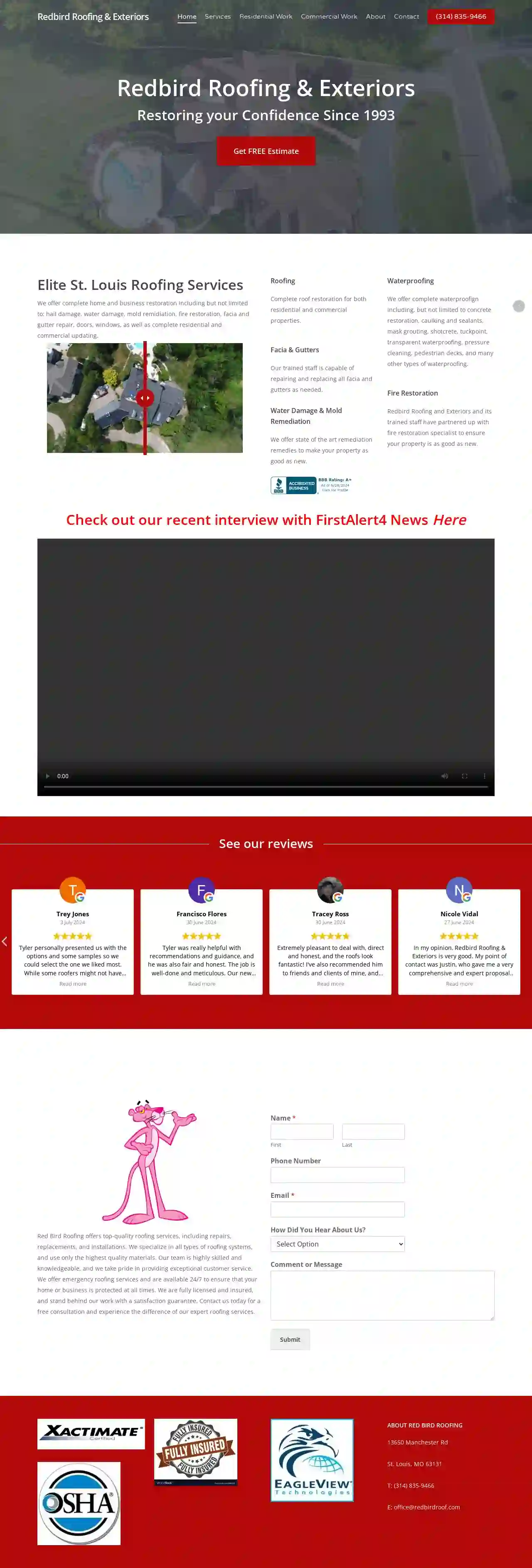Roofing Companies Hazelwood
Top 10 Roofers in Hazelwood
Receive 3 FREE Roofing Service quotes for your project today! Compare profiles, reviews, accreditations, portfolio, etc... and choose the best service.

Total Roofing St. Louis
558 reviewsSt. Louis, USAt Total Roofing, our team of experienced professionals is dedicated to providing top-notch roofing services to both residential and commercial properties. With a focus on quality workmanship and customer satisfaction, we have become the preferred choice for property owners in the Saint Louis area. Our team is fully licensed and insured. We follow current safety standards and undergo rigorous and regular training. We are committed to maintaining the highest safety standards for our team and clients. Our crew undergoes regular safety training, and we adhere to all industry regulations and guidelines to ensure a safe work environment.
- Services
- Why Us?
- Accreditations
- Our Team
- Testimonials
- Gallery
Get Quote
MLK Roofing & Construction
4.786 reviews1215 S. Jefferson Ave, St. Louis, 63104, USMLK Construction is a professional roofing contractor that provides honest, professional roofing services in Saint Louis, Missouri, and surrounding areas. With over 20+ years of experience, we are the go-to roofing company that succeeds in leaving our customers happy. We service residential, commercial, and industrial customers, and handle all jobs and styles of roofing, including slate, flat, clay tile, and more. Our team is dedicated to providing precision and professional workmanship to ensure a perfect and sturdy roof for all situations.
- Services
- Why Us?
- Our Team
- Testimonials
- Gallery
Get Quote
St. Louis Synthetic Roofing
52 reviews3740 Brown Rd., St. Louis, 63114, USWith decades of experience in the Roof industry, the Roofing Contractor professionals at St. Louis Synthetic Roofing are our region's dedicated composite roof specialists. Whether you're in the market for new roofs made from Synthetic Wood Shake shingles, Composite Slate Roofing, or Synthetic Spanish Tile Roofs, our professional roofers can help you. We are the leading composite roofing experts in the St. Louis area and the midwest at large offering both residential roofing and commercial roofing solutions.
- Services
- Why Us?
- Gallery
Get Quote
American Metal Roofing
4.917 reviews1000, Rolla, 65401, USAMERICAN. Metal. Roofing. When embarking on the journey of metal roof installation, finding the right metal roofing company can seem overwhelming. However, American Metal Roofing stands ready to guide you through every step of securing your ideal metal roofing for houses. We deeply understand the intricacies involved, from the investment in a metal roof to the specifics of metal roof repair, and commit ourselves to navigating these with you.Choosing American Metal Roofing means selecting a metal roof company that stands behind its work, ready to clarify any doubts and empower your decision with knowledge. Local, Trusted Metal Roofing in Rolla, MO St Louis • O'Fallon • Wildwood • St. Peters • Chesterfield • Wentzville • Ballwin • University City Why Metal Roofs? Metal roofing stands as a premier choice for both residential and commercial properties, distinguished by its remarkable durability, energy efficiency, aesthetic versatility, and cost-effectiveness. Engineered to endure severe weather conditions, metal roofs significantly outlast traditional materials, making them a favorite among metal roofing contractors. They reflect solar heat, slashing cooling costs and championing sustainable roofing with their eco-friendly, recyclable materials. Available in a myriad of styles, metal roofing enhances property value and curb appeal, proving to be a wise investment for those seeking a blend of performance and aesthetics. American Metal Roofing excels in providing top-tier metal roof installation and repair services, ensuring homeowners and businesses enjoy the long-term benefits of this superior roofing solution. We Pride Ourselves on Local Service At American Metal Roofing, our commitment to local service extends beyond mere words. We understand the importance of community and strive to be more than just a roofing company; we're your neighbors, your partners, and your trusted advisors in all things related to metal roofing. Whether you're a homeowner seeking a durable, long-lasting metal roof solution or a business owner in need of expert guidance on commercial metal roofing, we're here to provide tailored solutions that reflect our deep-rooted commitment to our local community. Choose American Metal Roofing for a roofing experience that not only exceeds expectations but also strengthens the fabric of our local neighborhoods. Get Estimate Now Roofing Excellence American Metal Roofing offers a wide ranges of metal roofing services including installation, repairs, and a variety of styles, catering to diverse architectural preferences. Customer Commitment We have expertise in delivering timely and effective metal roofing service, that emphasize our commitment to your satisfaction with quality workmanship. Metal Specialists A specialized focus on metal roofing solutions, promoting why metal shingles outperform other materials with durability, efficiency, and aesthetic versatility.
- Services
- Why Us?
- Gallery
Get Quote
Ferguson Roofing
3.680 reviews5814 Garfield Avenue, St. Louis, 63134, USFerguson Roofing is a St. Louis contractor specializing in quality roofing and exterior services for residential and commercial needs. We build more than roofs, we build relationships. The Ferguson Roofing family is ready to serve our neighbors. With 80 years of experience, we have built a reputation for providing exceptional customer service and quality workmanship. We offer an array of roofing styles, manufacturers, ventilation systems and pricing options. Our seasoned sales staff will meet with you to work through all of the necessary roofing items, ensuring that your biggest investment is in great hands. All of our residential roof replacements carry an unprecedented 15-year service warranty! We also provide storm damage repair, roof repairs, siding, soffit and fascia, and gutters services. We proudly serve the St. Louis community and are committed to providing the best possible experience for our customers.
- Services
- Why Us?
- Gallery
Get Quote
Roof America
51 reviewsSt. Louis, USRoof America is a family-owned business dedicated to providing top-notch roofing solutions for both residential and commercial properties in Arkansas, Kansas, Missouri, Oklahoma, and surrounding areas. We understand the stress that roofing emergencies can cause and strive to treat our customers like family, offering prompt, professional, and reliable service. Our team of experienced and licensed roofing contractors utilizes high-quality materials and industry-compliant practices to ensure lasting results. We are committed to exceeding customer expectations and delivering exceptional workmanship, whether it's repairing storm damage, restoring existing roofs, or installing new ones. We also offer financing and insurance assistance to make the process as smooth as possible.
- Services
- Why Us?
- Our Team
- Testimonials
- Gallery
Get Quote
Spartan Roofing LLC
4.832 reviews10000 Manchester Rd, Suite 100, St. Louis, 63124, USSpartan Roofing is a St. Louis based roofing company dedicated to providing high-quality workmanship and customer satisfaction. We understand the importance of a strong roof as your home's first line of defense against the elements. Whether it's wind, hail, or even a light spring rain, damage to your roof can lead to serious problems like mold growth, structural damage, and even animal intrusions. Our team of experienced professionals is committed to inspecting your roof thoroughly and identifying any potential issues. We offer a range of services, including roof repair, replacement, siding repair or replacement, and gutter cleaning and repair. We use only the best products in the industry and stand behind our work with a workmanship warranty and manufacturer warranties on shingles. At Spartan Roofing, we prioritize your peace of mind. We're known for our excellent customer service and strive to complete projects quickly and professionally. We're also fully bonded and insured, giving you added protection and assurance. Don't wait until a minor issue becomes a major problem. Contact Spartan Roofing today for a free estimate and let us protect your most valuable investment.
- Services
- Why Us?
- Gallery
Get Quote
Innovative Construction & Roofing
4.865 reviews10850 Baur Blvd, St. Louis, 63132, USInnovative Construction & Roofing is an experienced roofing contractor with headquarters in St. Louis, MO. We specialize in commercial roofing as well as specialty roofing such as slate and tile. We have repaired and replaced thousands of commercial and residential roofs in the St. Louis metropolitan area.
- Services
- Why Us?
- Gallery
Get Quote
Roofing Force
4.990 reviewsOlathe, KS, 529 N Lindenwood Dr, 66062, USRoofing Force is committed to delivering the best service, materials and value on every roofing, siding, window, gutter, painting and interior restoration job. We are a licensed Residential Building Contractor, a Residential Roofing Contractor, a Commercial Roofing Contractor, and experts in new and replacement roofs, roof repairs, and complete storm damage recovery including helping you with the insurance claims process. Our goal is to give you the best experience you have ever had with any company! We Always Do the Right Thing. A+ BBB RATING. Hundreds of 5 Star Google Reviews. Roofing Force is ✅ Google Guaranteed. Licensed & Insured in Kansas, Missouri, Illinois, Oklahoma, Arkansas, Nebraska and Iowa. The Best Roofing Materials. Looking for the Best Roofing Materials? Unlike most roofing companies that only install or repair asphalt shingles, we at Roofing Force are experts in all styles of roofing products and we offer the best roofing systems. Did you know that there are state-of-the-art materials including architectural shingles, stone coated steel, stamped metal, polymer composite, concrete, wood shake, stone slate and metal panel roofing products that last longer, provide better storm protection and energy efficiencies than traditional asphalt shingles and are guaranteed to improve the curb appeal of your home? On the commercial roofing side, in addition to asphalt, metal and composite roofing products, we install flat roofing materials including EDPM, PVC, TPO, and Foam. Concerned about quality? At Roofing Force, we only install products from the best manufacturers including: Unified Steel (Formerly Boral Steel/Gerard), DECRA, Tilcor, Varitile, Future Roof & Interlock (Exclusive Installer), Enviroshake (Factory Trained Contractor), Brava Roof Tile, DaVinci Roofscapes (Masterpiece Contractor), Inspire, CeDUR, Owens Corning (Platinum Preferred Contractor), CertainTeed (ShingleMaster), GAF, TAMKO (Pro-Certified Contractor), Malarkey, and Metal Panels Inc. We also have our own Standing Seam Metal Fabrication Machine and the most experienced and efficient installation crews in the Midwest. We will do a thorough clean-up of your job.
- Services
- Why Us?
- Accreditations
- Our Team
- Gallery
Get Quote
Redbird Roofing & Exteriors, LLC
4.671 reviewsSt. Louis, MO, 13650 Manchester Rd, 63131, USRedbird Roofing & Exteriors is a St. Louis-based company that has been restoring confidence since 1993. We offer complete home and business restoration services, including hail damage, water damage, mold remediation, fire restoration, facia and gutter repair, doors, windows, and complete residential and commercial updating. Our team is highly skilled and knowledgeable, and we take pride in providing exceptional customer service. We are fully licensed and insured, and stand behind our work with a satisfaction guarantee.
- Services
- Why Us?
- Our Team
- Gallery
Get Quote
Over 17,196+ Roofing Companies registered
Our roofing experts operate in Hazelwood and surrounding areas!
Roofyng.com has curated and vetted Top Roofing Contractors in and around Hazelwood. Find the most trustworthy pro today.
Frequently Asked Questions About Roofing Companies
- Age: If your roof is nearing or exceeding its expected lifespan, it's wise to consider replacement.
- Multiple Leaks: Several leaks or leaks that reappear after repairs suggest a widespread problem.
- Extensive Damage: Large areas of damaged, missing, or deteriorated roofing materials might be too costly or difficult to repair effectively.
- Sagging or Structural Issues: Sagging, deflection, or other structural issues indicate a compromised roof that needs replacement.
- Granule Loss (Asphalt Shingles): Significant granule loss indicates weathering and reduced protection.
- Curling or Buckling Shingles: Signifies age or improper ventilation.
- Increased Energy Bills: A poorly insulated roof can lead to higher heating and cooling costs.
- Choose Reflective Roofing Materials: Opt for light-colored shingles or metal roofing that reflects sunlight and reduces heat absorption.
- Install Proper Attic Insulation: Adequate insulation prevents heat loss in the winter and heat gain in the summer.
- Ensure Adequate Ventilation: Proper attic ventilation allows hot air to escape, reducing cooling costs and extending the lifespan of your roof.
- Consider a Radiant Barrier: In hot climates, a radiant barrier installed in the attic can reflect heat away from the roof, further reducing cooling needs.
- Ventilation: Soffit vents provide intake ventilation, allowing fresh air to enter the attic and regulate temperature and moisture.
- Aesthetics: It creates a finished look to the roof's underside.
- Pest Control: A properly sealed soffit prevents pests like birds and squirrels from nesting in the attic.
How often should I clean my gutters?
What are the signs that my roof needs to be replaced?
How can I make my new roof more energy-efficient?
What is a soffit, and why is it important for my roof?
How often should I clean my gutters?
What are the signs that my roof needs to be replaced?
- Age: If your roof is nearing or exceeding its expected lifespan, it's wise to consider replacement.
- Multiple Leaks: Several leaks or leaks that reappear after repairs suggest a widespread problem.
- Extensive Damage: Large areas of damaged, missing, or deteriorated roofing materials might be too costly or difficult to repair effectively.
- Sagging or Structural Issues: Sagging, deflection, or other structural issues indicate a compromised roof that needs replacement.
- Granule Loss (Asphalt Shingles): Significant granule loss indicates weathering and reduced protection.
- Curling or Buckling Shingles: Signifies age or improper ventilation.
- Increased Energy Bills: A poorly insulated roof can lead to higher heating and cooling costs.
How can I make my new roof more energy-efficient?
- Choose Reflective Roofing Materials: Opt for light-colored shingles or metal roofing that reflects sunlight and reduces heat absorption.
- Install Proper Attic Insulation: Adequate insulation prevents heat loss in the winter and heat gain in the summer.
- Ensure Adequate Ventilation: Proper attic ventilation allows hot air to escape, reducing cooling costs and extending the lifespan of your roof.
- Consider a Radiant Barrier: In hot climates, a radiant barrier installed in the attic can reflect heat away from the roof, further reducing cooling needs.
What is a soffit, and why is it important for my roof?
- Ventilation: Soffit vents provide intake ventilation, allowing fresh air to enter the attic and regulate temperature and moisture.
- Aesthetics: It creates a finished look to the roof's underside.
- Pest Control: A properly sealed soffit prevents pests like birds and squirrels from nesting in the attic.